Cartier Pasha
Click here to watch a video about the history and appeal of "Pasha" ↓
In this article, we will explain the Pasha, Cartier's only sports model.
You've probably heard the name "Pasha" before and probably have a general idea of what kind of watch it is, but if you look closely, you'll see that there are actually several slightly different Pasha models available.
Although we may think we know about it, we don't really know much about the Pasha. In this article, we will explain in detail what kind of model it is, what its appeal is, and what kind of history it has.
By the time I finish reading the article, I'm sure this watch will be my best choice!
I believe you will now be able to come up with a set of criteria for judgment, so please read to the end.
The table of contents is included in the description, so please take a look there if there is anything you are interested in.
The history of the Pasha
Originally, Cartier had a model called the Tank Etanche, a waterproof watch designed by Jaguar in 1931.
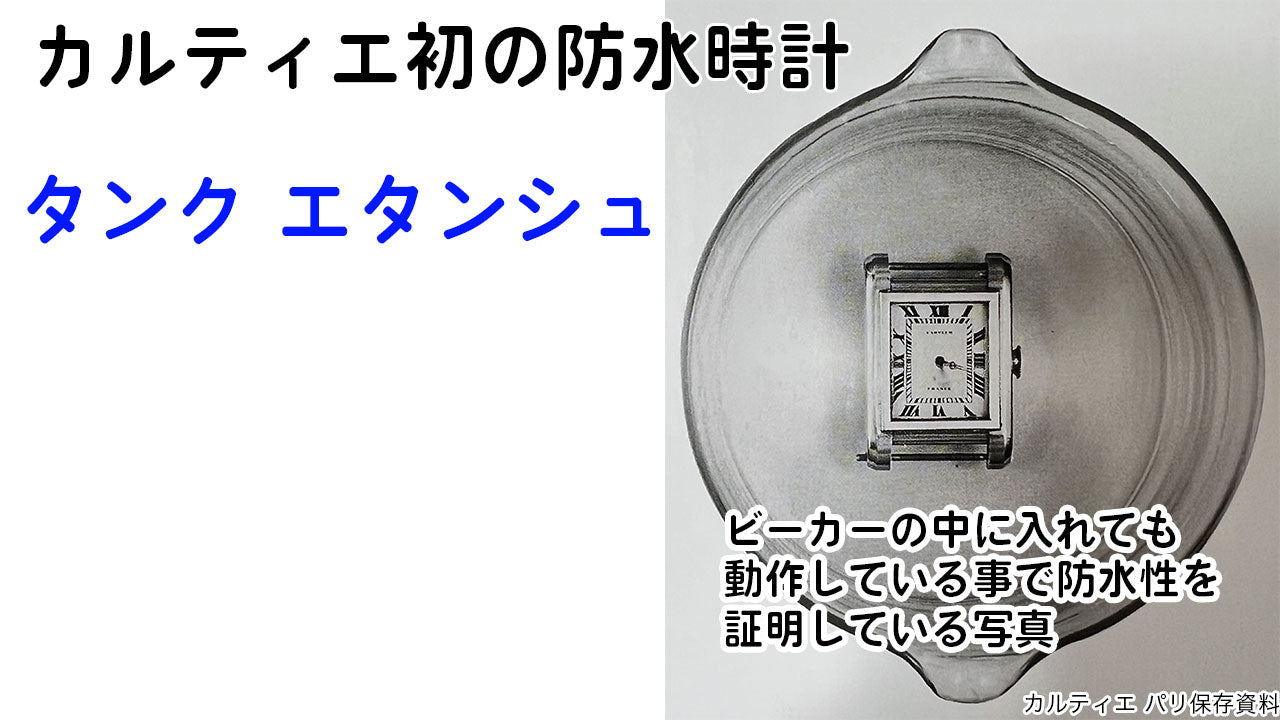
However, although this has not yet been realized, rectangular or square shaped watches are not suitable for waterproof watches because the corners of the watch cause problems with waterproofing.

Later, in the mid-1930s, Prince El Chavis, who was the Pasha of Marrakech in Morocco at the time, asked Louis Cartier, the third generation owner of Cartier, to create a waterproof watch that he could use while swimming in his home pool. This is how it all began.
However, at that time, the only waterproof watch available was the Etanche, and the first "Pasha" was born in 1943, and it had a round shape.
Therefore, Cartier gave up on the imperfect waterproofing of square watches and over the years created a realistic waterproof round watch. It was named in honour of the Pasha of Marrakech.
This first completed Pasha was produced in limited numbers and was not available for sale to the public.
This model disappeared from Cartier for a while after that, but about 40 years later, in 1985, it was officially added to Cartier's watch lineup.
Due to this background, the model was classified as a high-end model that was more geared towards men and was also available in solid gold and with a chronograph.
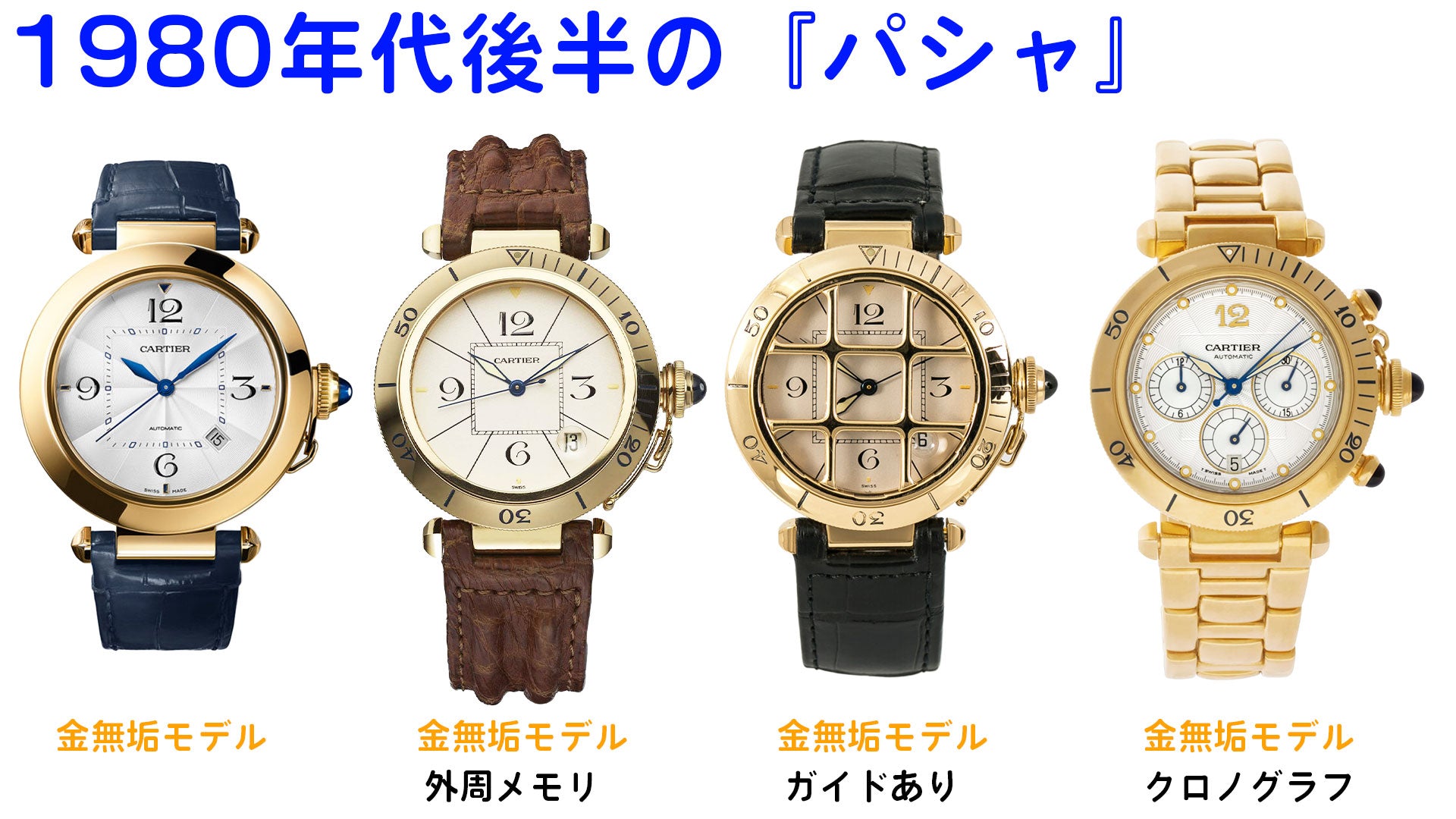
The original Pasha design was created by Gerald Genta, known as the Picasso of the wristwatch world, and was a model that was created with great enthusiasm.
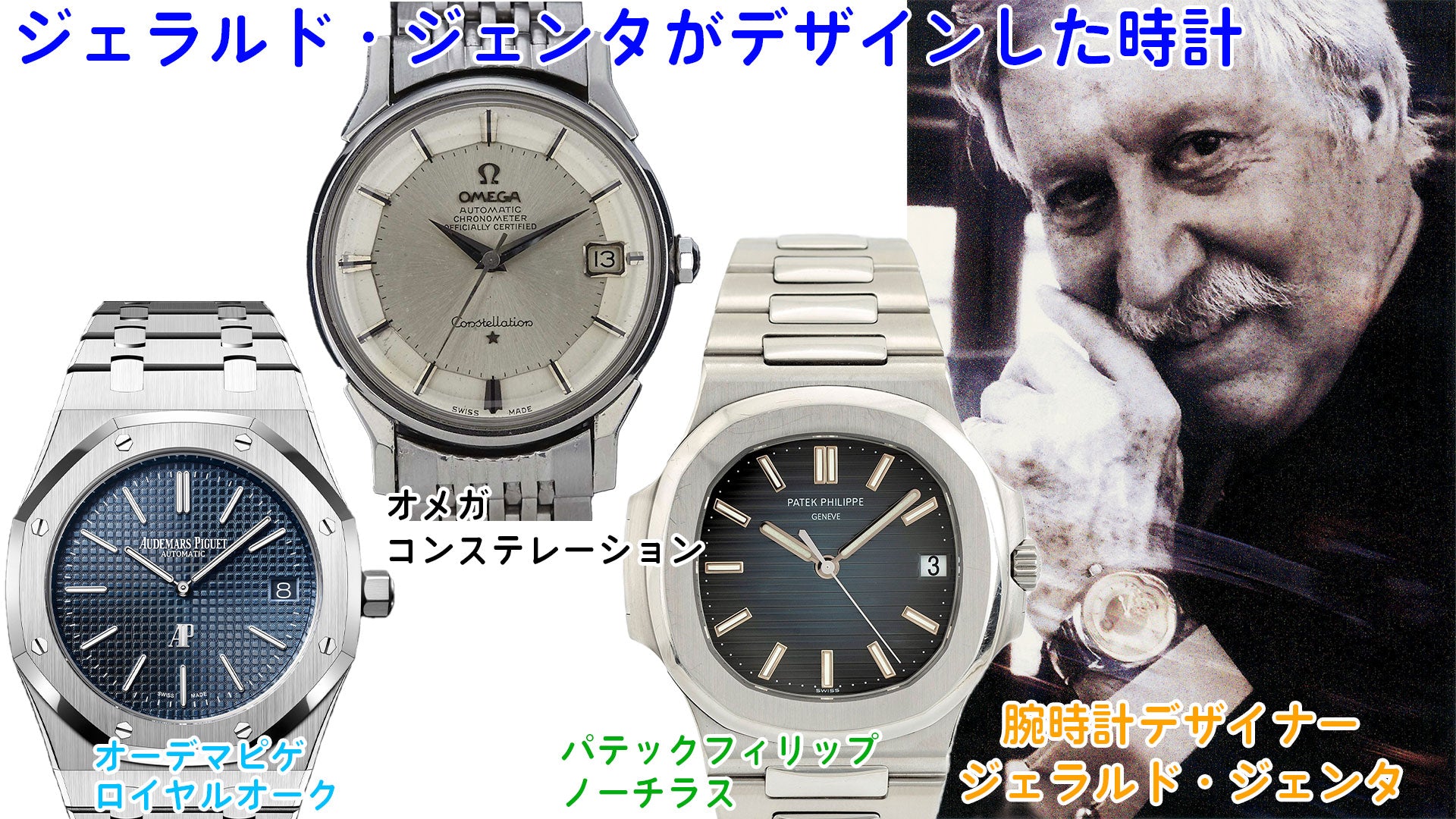
However, the tide began to turn in 1995.
In an effort to create a more casual watch, the new "Pasha C" has been introduced, made entirely of stainless steel.

As a result, the Pasha, which had previously been developed as a men's watch, was reborn as a watch primarily for women.
I think it was around this time that the image of Pasha as a watch more geared towards ladies was created.
Production continued for a while after that, but it disappeared in 2016 and will be revived again in 2020.
The revived Pasha series once again includes pink and yellow solid gold models, diamond models, and chronograph models.
Although production has ceased, The Pasha model has a long history, and many models have been created during that time, and they are still on sale today.
Let's take a look at the crown that makes the watch waterproof
So, let's take a look at how the Pasha is able to achieve waterproofing.
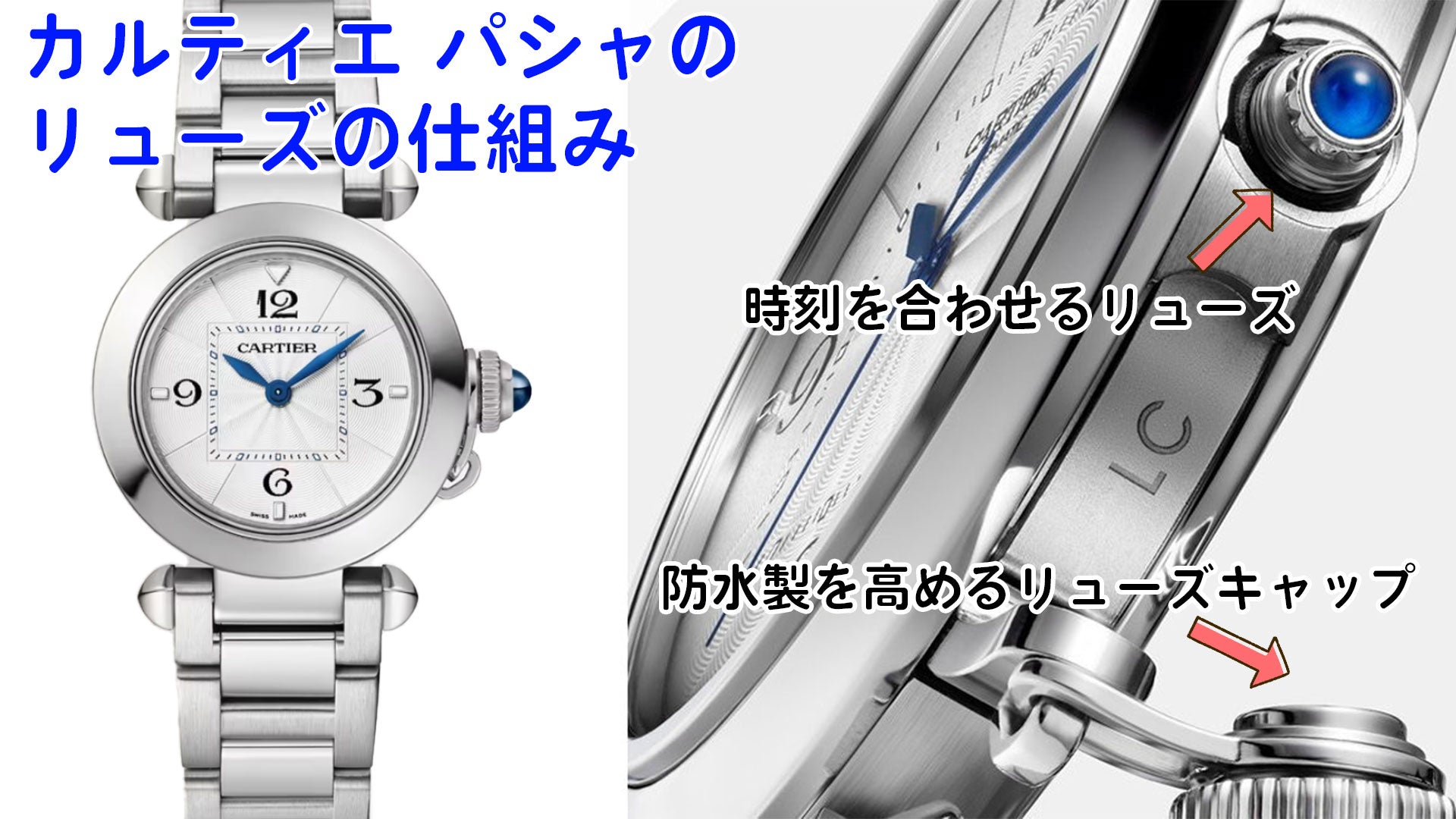
Water can seep into a wristwatch through the back cover or the crown, but the Pasha's water resistance is improved by attaching caps to the points where water can enter.
In addition, the crown cap is attached to a chain via a protector to prevent it from getting lost when removed.
The cap is installed to improve water resistance, but in the hands of Cartier, it is a truly beautiful design.
Perhaps it is the cabochon, which has become an icon of Cartier, that makes the watch look so elegant.
Now let's take a look at the variety of stones on the tip of the cap.
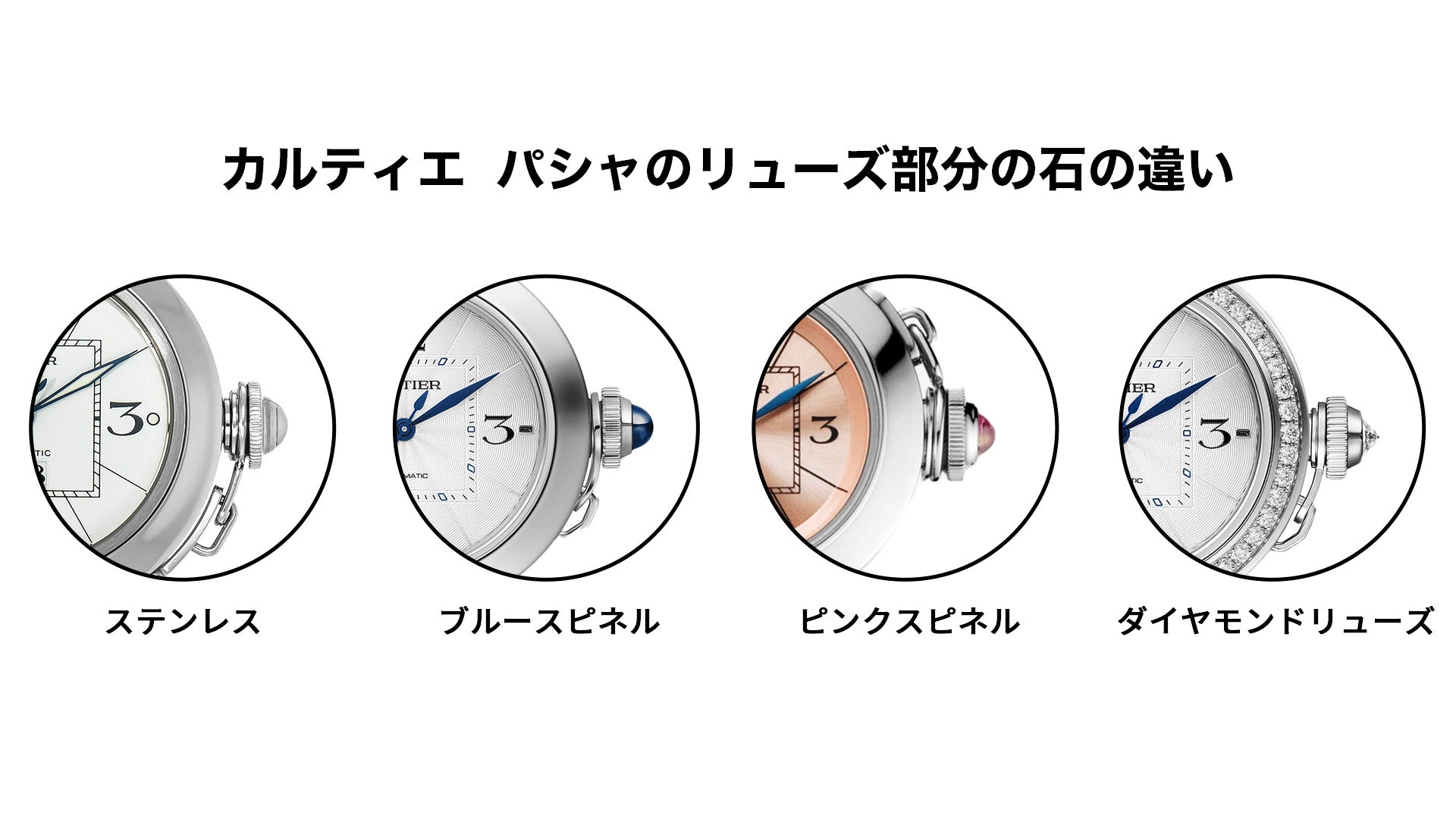
Let's take a look at the size of the current Pasha model.
As mentioned above, Pasha has a long history and many different models have been created and discontinued, so there are many variations.
First, let's look at the current size range.
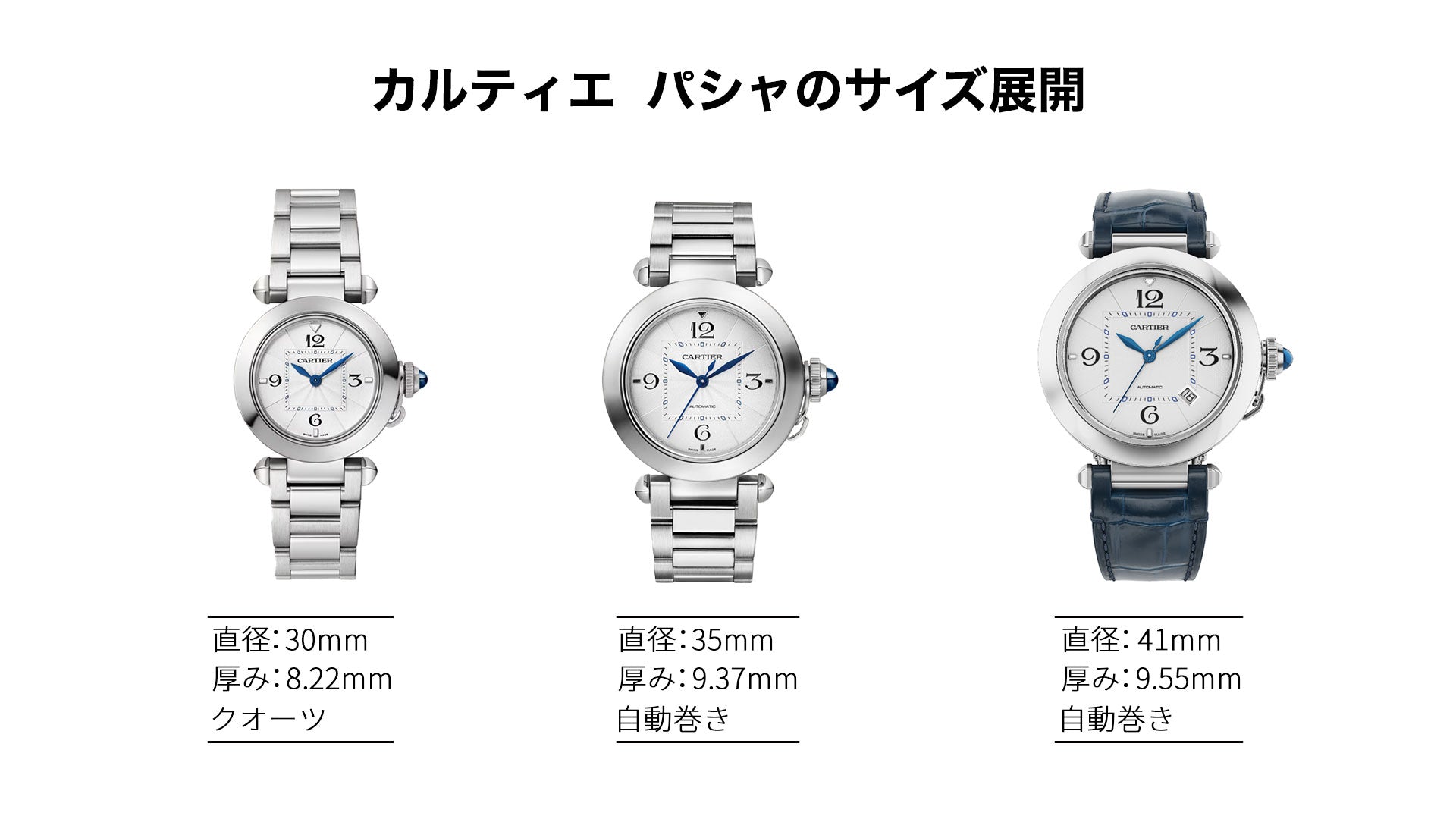
It is available in 30mm, 35mm and 41mm, and does not have the SM, MM, LM designations commonly used by Cartier.
However, if we were to classify according to a different model,
SM is 30mm and is a ladies model.
MM is 35mm and it is a unisex model.
LM is 41mm, men's model
It would be.
Now let's take a look at the movement together.
The 30mm model is clearly designed for women as it contains quartz.
The 35mm model is fitted with an automatic movement.
As a woman, I think 35mm is quite big.
However, if you are an adult woman who prefers hand-wound or automatic movements over quartz, I think this 35mm size would also be a good option.
On the other hand, men may find 35mm a little lacking.
Therefore, I think this 35mm model is geared towards women.
The 41mm model is clearly designed for men, due to its size and the automatic movement.
However, we're sure there are some women in particular who won't find their favorite size here, so from here on out, we'll take a look at all of the discontinued models (sizes).
Size range of the discontinued Pasha
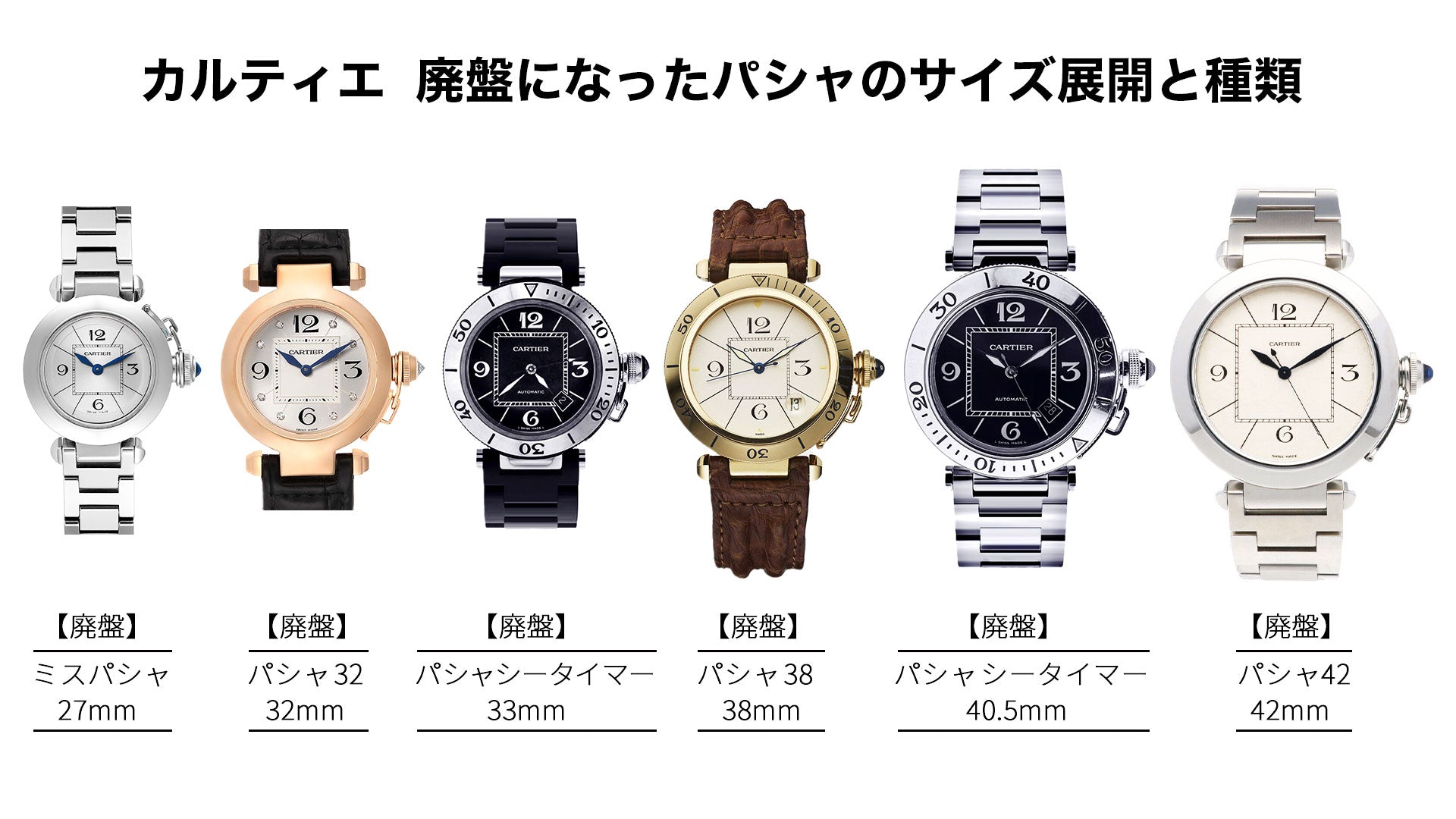
It's out of production, but if you look you can easily find it on the second-hand market, so if you see something that interests you, give it a try.
Looking at other current Cartier models, there are several with case diameters of less than 20mm or in the low 20mm range.
In this context, the current Pasha model has a minimum lens diameter of 30mm, which many people may find a little large.
In fact, Pasha also had a smaller model in the past.
One such model is the "Miss Pasha," which was launched in 2009 and discontinued in the mid-2010s.The case diameter is 27mm, which is not large compared to other models and is thought to be a good size for slender Japanese women.
Next is the Pasha 32, which has a case diameter of 32mm, which I think is also an easy size to choose for a women's watch.
Next comes the Pasha Seatimer, which has a 1mm larger case diameter and looks more casual and sporty, followed by the 35mm model that remains in the current model.
This is just my personal opinion, but I think it would be easier for women's watches to be available in 27mm, 30mm, and 32mm, but Cartier may not think that offering too many sizes is a good idea.
Now let's look at the men's.
For men, there was the Pasha 38 with a 38mm case diameter, followed by the Pasha Seatimer at 40.5mm, and then the Pasha 42 with a 42mm case diameter model.
Therefore, the men's model looks like it has been made by unifying the 38mm and 42mm to create the 41mm.
Differences between Miss Pasha and the current Pasha
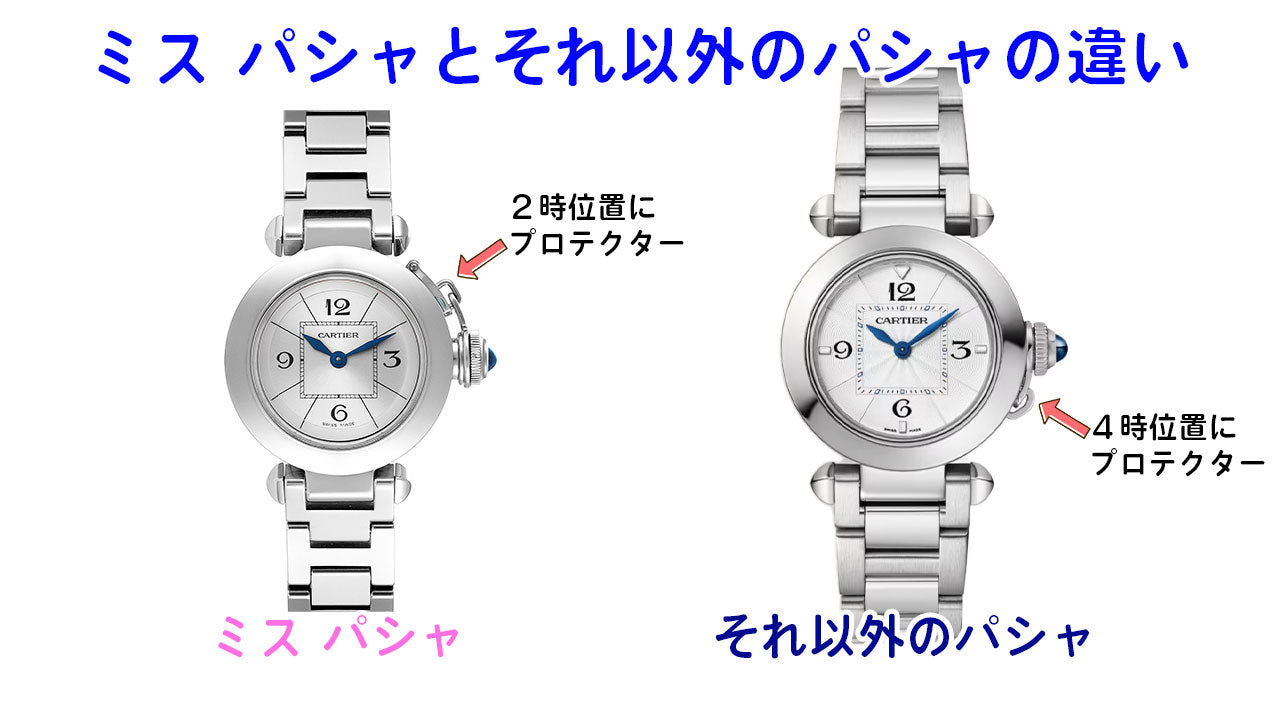
The one on the left is Miss Pasha and the one on the right is Pasha.
The position of the protector is different between these two models.
The Miss Pasha has the protector at the 2 o'clock position, while the other models have it at the 4 o'clock position.
If you are looking for Miss Pasha, you can locate her by the location of this protector.
Let's take a look at the dial variations
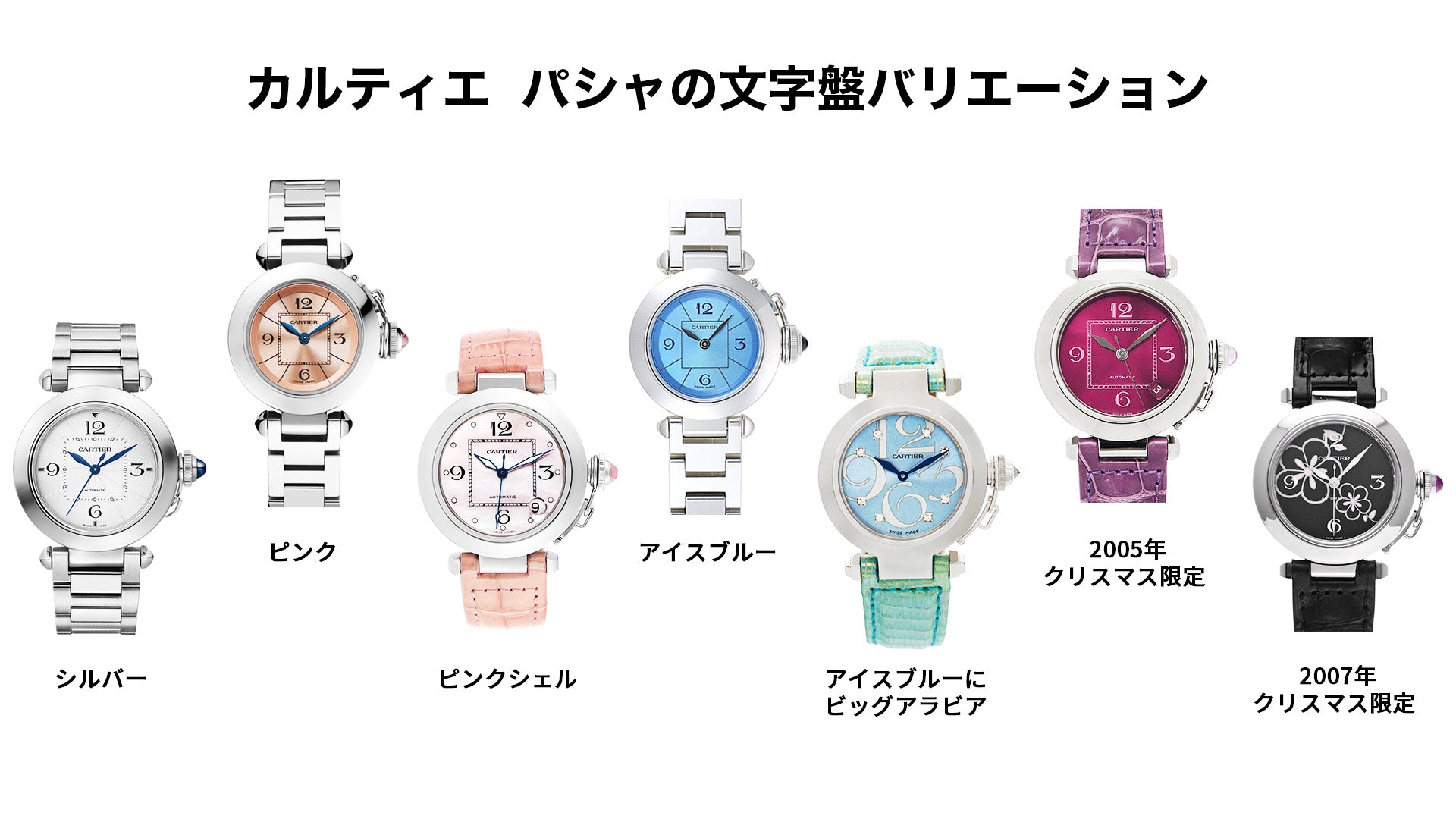
If you look at the dial of the Pasha model, you will see that it has a square case and Roman numerals, which are characteristic of Cartier watches. It has a plump, rounded case and stylish Arabic numerals, making it a rare find.
The original Pasha was created in the 1940s, but even today its design is beautiful and modern, making it a sporty yet luxurious watch.
The Pasha has a long history, so there are many variations in the dial.
Although we cannot introduce all of them, we will introduce the dial variations that were commonly sold.
It has a typical off-white silver dial, and this is the standard model that you will generally see.
Although simple, the design is accented with blue steel hands and blue cabochons, making this a model that gives you a sense of the origins of Pasha.
And the light blue and pink dial is for the ladies' Miss Pasha.
After all, the fact that they offer these kinds of color variations means that having just one can broaden your fashion options and complete your outfit with just that.
From here onwards we will be introducing the limited editions, both of which have cute designs.
First up is the 2005 Christmas limited edition model, which has a darker pink dial compared to the regular pink.
It's a glossy, vibrant pink, making for a vibrant design that will brighten up your wrist.
The next design is Winter Flowers, which was released as a limited edition for Christmas in 2007. It features cherry blossom-like flowers and an Asian-style illustration that is familiar to us Japanese people, so it seems like it will fit in well.
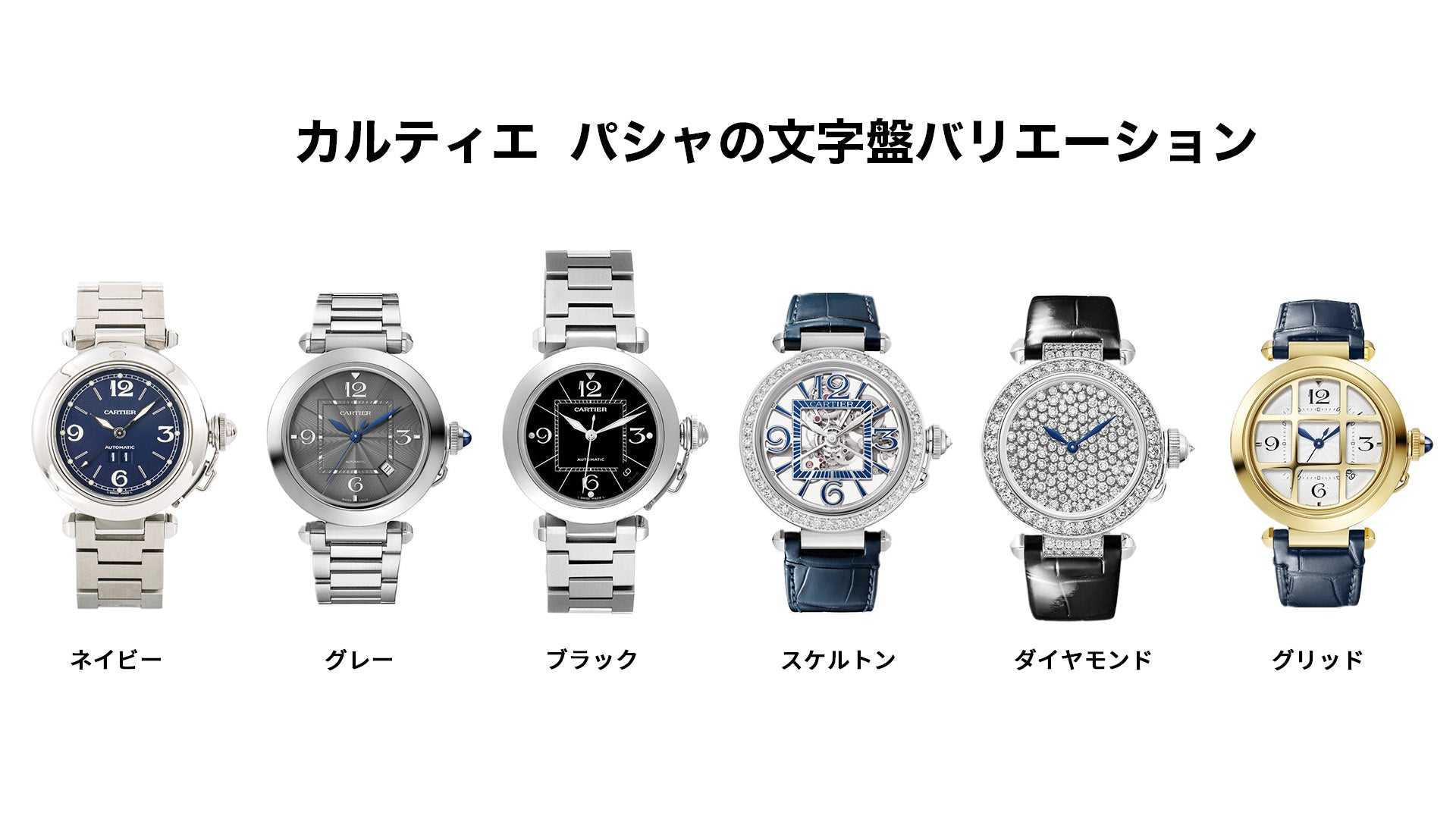
The men's line comes in dial colors that men love: navy, gray, and black.
This is a luxury line that is not often found in other models, and it comes in ``Skeleton'' and ``Diamond''.
The appeal of skeleton watches is that you can enjoy the beauty of their mechanical design.
I believe the beauty of a watch includes its movement, so being able to see each of these parts from both the front and back like this is wonderful.
However, it seems that this feeling is stronger among men, and judging from the size range, there are no skeleton models for women.
On the other hand, the diamond model fills that gap.
We have a very glamorous lineup, including models with diamonds on the bezel, diamonds on the dial, and models with diamonds all over the dial.
I think the sparkle of diamonds suits women better, and it brings out their feminine charm.
The last thing I'll introduce is the Grid.
This is attached by a snap-in mechanism, but originally this grid was attached to military watches and served as a kind of cover to protect the crystal (glass surface).
It actually disappeared from wristwatches because the only time it had any practical use was during wartime.
Of course, the reason this grid is attached to the Pasha is not to protect the crystal, but rather to serve as part of the decoration.
What's the difference between the old Pasha and the new Pasha?
At first glance, there doesn't seem to be much difference between the Pasha before 2020 and the Pasha after, but the protector part has actually been changed.
So please take a look at this image↓
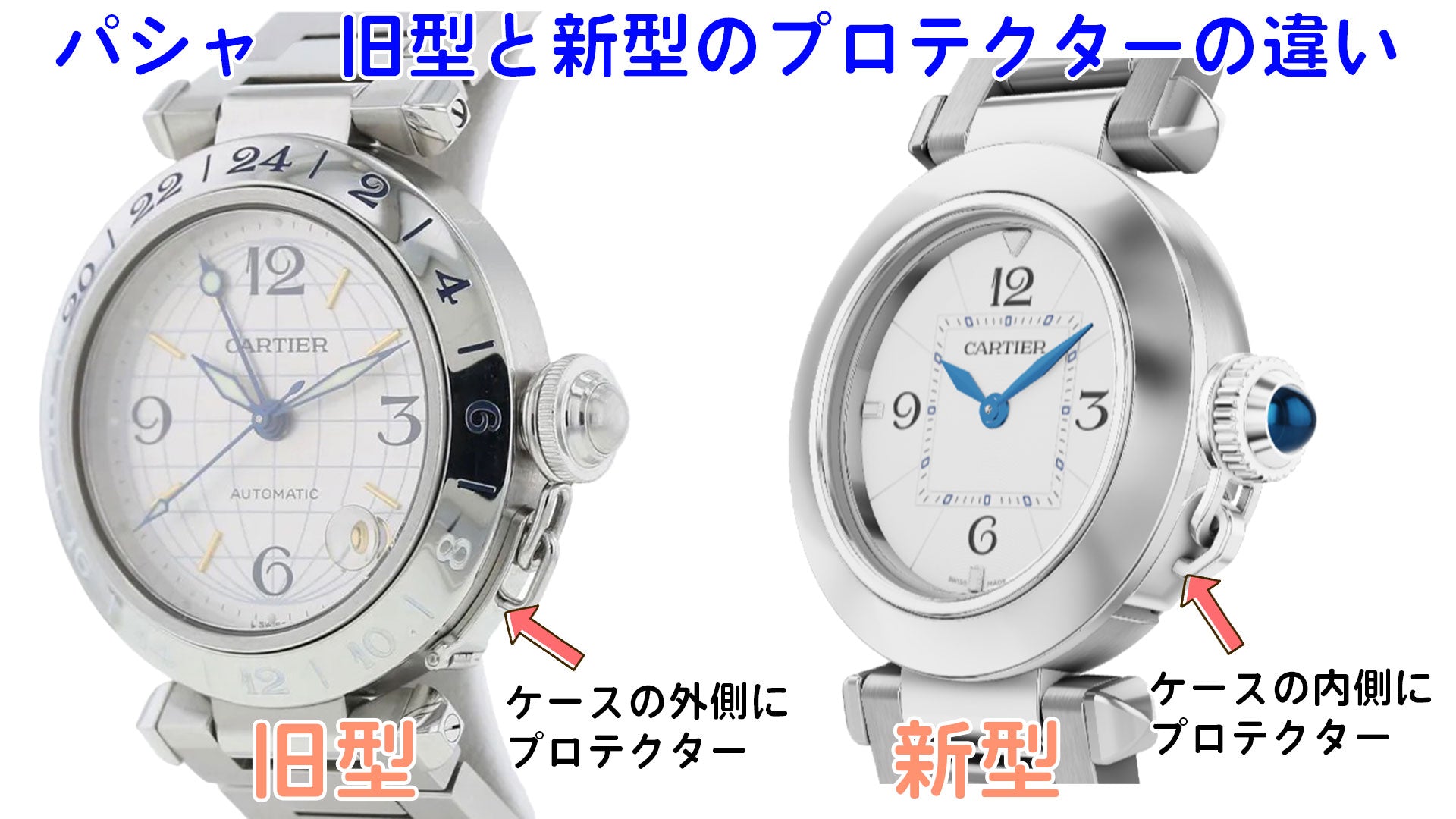
The old protector is attached to the outside of the case, just like a new part.
On the other hand, in the new model, the protector fits inside the case, creating a unified look without interfering with the case's streamlined shape.
Comparing the two, the old model has a rugged and sporty look, while the new one is sharper and more luxurious, giving it a modern impression.
Cartier doesn't have a very cluttered brand image, so I think the new model is more Cartier-like.
summary
This model was originally created as part of the men's line, so it's interesting to look at past models as there are many different types.
Also, since the design was created by Gerald Genta, it is beautiful yet sporty, giving it a charm that is not found in other models.
As you can see from Cartier's official website, there are a large number of models available, so you should be able to find one that suits your taste.
By learning about the history and understanding how the watch was created, you will feel more attached to it and want to cherish it for a long time.